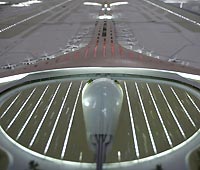OLYMPICS/ Facelift
Beijing shows new airport terminal for Olympics
(AP)
Updated: 2007-09-13 06:04
BEIJING - Beijing showed its new airport terminal Wednesday, a mammoth glass and steel structure with a gracefully sloping roof to impress visitors to China's capital for the 2008 Olympics.

A general view of a miniature replica of the new terminal of Beijing's International Airport in Beijing September 12, 2007. [Reuters]
|
Terminal 3 at the Beijing Capital International Airport is a centerpiece project for the Olympics designed to relieve the overloaded airport's other two terminals and accommodate the city's torrid growth for the next seven years, executives with the airport's state-run holding company said at a tour for foreign media.
The terminal, which is scheduled to open for testing in February and full operation in July, is outfitted with a state-of-the-art baggage handling system, a rail terminal to carry passengers into the city and gates and a runway capable of handling Airbus' huge A380 superjumbo.
The terminal building costs 21 billion yuan (US$2.8 billion), and 35 billion yuan (US$4.6 billion; euro3.4 billion) with all the related infrastructure added in, the executives said.
The terminal is an "important non-competition venue" for the August 8-24, 2008, Olympics, said Zhang Zhizhong, general manager of Capital Airport Holding Co.
A huge undertaking, the new terminal, its runway and most of the related infrastructure will have been built on a compressed timetable of four years.
Construction involved 50,000 people worked on the site at any one time, 500,000 tons of steel were used, and a plane is expected to take off or land about once every 30 seconds, according to statistics provided by the city government and the holding company.
"The scale was our biggest problem," said Yuan Xuegong, deputy head for the expansion project's headquarters.
Designed by British architect Norman Foster, the building attempts to combine traditional architectural elements with up-to-date technology. Its red columns and muted gold roof are meant to evoke Beijing's imperial palaces and temples while the baggage system, made by German engineering giant Siemens AG's China subsidiary, can handle 19,000 pieces of luggage an hour, the executives said.
Beijing desperately needs a new airport, with the double-digit economic growth of recent years outstripping city planners' original projections and stressing the capital's infrastructure. The capital airport's second terminal, which opened eight years ago, quickly reached its limits, and long lines for check-in and flight delays are common.
"If you fly in and out of Terminal 2, you know what a headache that is," said Jeff Martin, a Florida resident and project manager for Siemens' baggage handling system. "There should not be that problem here because they've done a lot of studies on passenger flows."
Passengers using the current airport have increased more than 20 percent annually, to 48.6 million last year, from 21.7 million in 2000, and the airport has risen from being the world's 42nd to 9th busiest by passenger numbers, according to the holding company.
When the new terminal is fully operational, the airport will be able to handle 62 million passengers, a limit the holding company expects to reach in 2015.
In the meantime, with Beijing's growth spurt to expected to continue well beyond the Olympics, the holding company is looking for space to add another runway and terminal to the airport, and the city government has set up a committee to find a site for a second airport.
|